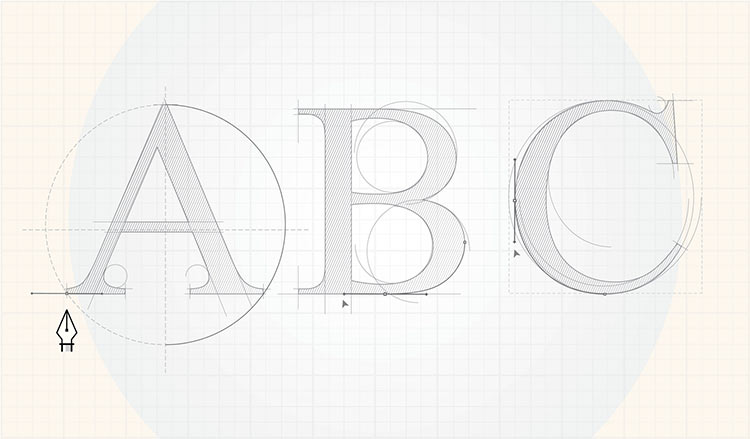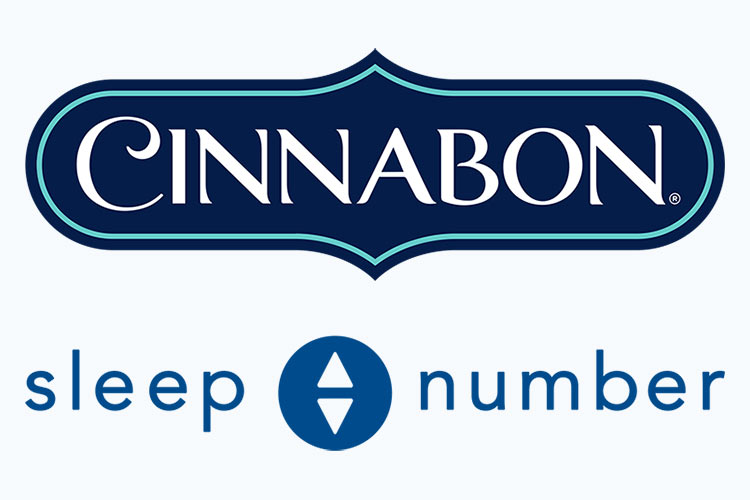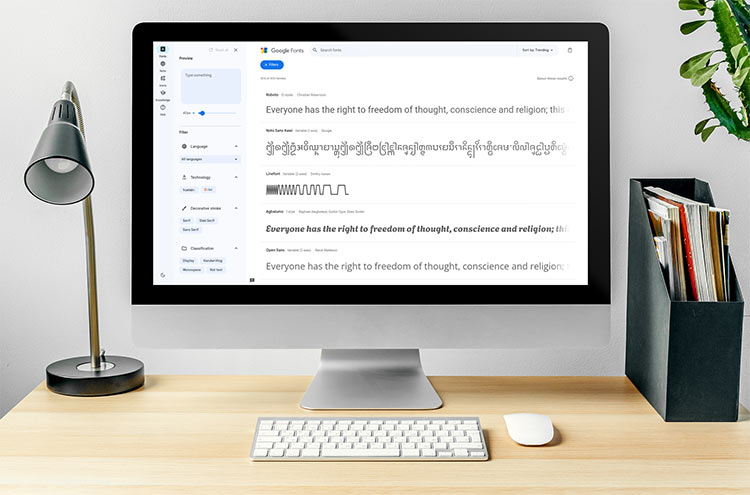For small business owners, understanding the psychology behind type can be a game-changer. It’s not just about the words you write but also about the character in which they’re presented. A font can whisper, shout, joke, or teach with subtle authority. It’s the silent ambassador of your brand, working tirelessly to tell your story.
In the vast sea of typographic choices, how do you find the font that tells your story best? How do you ensure that your chosen type aligns with the vision and voice of your business? Whether you’re a roofing company, a law firm, or a pet groomer, there’s more to your font decision than just serif or sans-serif.
In this comprehensive guide, we’ll explore everything from the mood set by font choice to the nitty-gritty of font licensing. We’ll walk you through the steps to identifying the font that not only matches your brand’s core message but enhances it, all while providing examples from recognized brands such as Cinnabon and Sleep Number.
So tighten up your laces; we’re about to journey into the world of typography, where font choice is an essential cornerstone of digital marketing strategy and brand identity. Whether you’re crafting your first logo or revamping your website, let’s unlock the secrets behind the letters that can define your brand’s success.
Table of Contents

Understanding Typography and Brand Personality
Before you choose a font that will represent your brand, it’s critical to understand the basics of typography and its deep connection with brand personality. Typography is not just the art of arranging type; it’s a powerful voice in its own right. Your font style—whether it’s a sturdy serif, a clean sans-serif, a technical monospace, or a casual script—can influence how your message is received and how your brand is perceived.
Serif vs. Sans-Serif – Beyond the Basics
Traditionally, serif fonts, known for their decorative ‘feet’ at the end of letter strokes, are associated with reliability, respectability, and a sense of history. Think of The New York Times, which uses a serif font to embody authority and trustworthiness. On the other hand, sans-serif fonts strip away the flourishes for a sleek, modern look that can feel approachable and clean—attributes that tech giants like Google embrace.
Understanding Font Moods and Values
Every font carries its own mood. A font like Comic Sans, for instance, is informal and fun, but might not be taken seriously in a corporate context. Meanwhile, a font like Times New Roman suggests a formal, business-like atmosphere. By aligning the mood of your font with your brand’s values, you can ensure that your written words carry the emotional tone that matches your brand’s character.
Exercises to Define Brand Personality
Before you can decide on a font, you need a clear understanding of your brand’s personality. Here’s an exercise: Describe your brand as if it were a person. Is it a he or a sage mentor with years of wisdom? Is a young and energetic friend full of innovative ideas? Or perhaps a warm and nurturing figure offering comfort and reliability? Once you’ve characterized your brand, you can begin to see which font characteristics resonate with your vision.
For instance, a brand that wishes to present itself as trustworthy and professional might opt for a strong, stable serif font. In contrast, a brand looking to emphasize its modern, forward-thinking attributes may choose a minimalistic sans-serif. The key is to use typography to amplify the characteristics you want your brand to project.
Practical Considerations
When you’re thinking about font personality, don’t forget to factor in practicality. Consider readability, especially for online content where attention spans are short. A good brand font should be legible across different mediums, from your website to print ads.
By understanding the relationship between typography and brand personality, you can begin to approach font selection as a strategic brand decision, not just a stylistic choice. Next, we’ll analyze how recognized brands use this knowledge to select fonts that resonate with their customers and fortify their branding success.

Decoding Font Messages with Recognized Brand Case Studies
The fonts that some of the most recognized brands use aren’t chosen by accident. These brands employ typography to subtly convey their core brand message and values. Let’s unpack how specific font characteristics work in the wild with case studies from Sleep Number and Cinnabon, among others, to illustrate just how a font can make all the difference in brand perception.
Sleep Number – Comfort in Every Curve
Sleep Number has carved out a niche in the competitive mattress market by emphasizing personal comfort and better sleep through its products. The company’s choice to use lowercase in its branding reflects this message with intention and precision. Lowercase letters are often perceived as less dominating and more inviting, which parallels the comfort and ease one associates with a good night’s sleep. The gentle curves and soft lines of the lowercase font with no harsh edges, are much like the experience of sinking into a Sleep Number bed. By choosing a font that mirrors the product experience, Sleep Number’s typography reinforces the brand’s promise of customized comfort and relaxation.
Cinnabon – The Art of Appetite in a Font
Cinnabon’s iconic ‘C’ not only stands out as a visual centerpiece but also plays a key role in evoking the sensory experience their brand offers. The font’s most distinguishing feature, the curl on the ‘C,’ represents the act of unrolling one of their warm, sweet cinnamon rolls. This single character captures the essence of the brand – indulgence, warmth, and the handmade quality of their product. The swirls mimic the cinnamon rolls’ spirals, and the strategic use of typography conjures up memories and desires for the gooey, cinnamon-filled treats. The use of a script-like, whimsical font throughout their branding completes this image by adding to the handmade, personal feel.
These case studies exemplify how a font choice can extend beyond aesthetics to encapsulate a brand’s ethos and market position. By aligning a typeface with the attributes of their products, these brands strengthen their identity and ensure that their messaging resonates on a visual level with consumers.

Finding Your Brand’s Font
With an understanding of how major brands use typography to their advantage, it’s time to turn the spotlight on your business and the process of selecting a font that fits. The journey of choosing your brand’s font begins with identifying the core attributes you want to communicate to your audience. This decision-making process is as strategic as it is creative, and it involves a deep dive into the nature of your brand, your industry norms, and your customer’s expectations.
Start by reflecting on the primary traits you want customers to associate with your brand. Are you aiming to be seen as authoritative and established, or fresh and innovative? These traits should guide your typographic direction. An established brand might lean towards serif fonts, which are often linked to tradition and reliability, while a startup keen on showing off a modern edge might look towards a clean, sans-serif typeface.
Next, consider the practicality of your typeface in all the realms your brand will touch. A font that works well on your website’s header might not translate as well on mobile screens or printed material. Think about the versatility of the typeface and test it across different mediums. This will ensure that the font remains legible and effective, whether it’s displayed on a billboard, a business card, or a digital ad.
When pondering uniqueness, remember that your font can set you apart from competitors. It’s here where custom font creation might come into play, especially if your branding needs that exclusive touch. However, it’s essential to balance uniqueness with accessibility. A font that’s too quirky may detract from readability and fail to communicate effectively. Aim for a font that embodies your brand’s personality while still being functional for daily use.
While exploring typefaces, also think about the future. Ask yourself how the fonts you’re considering will age over time. Will they still be as effective and relevant in five years? Your brand is likely to evolve, and so your typography should be able to stand the test of time or be adaptable to changes in your branding.
After you’ve narrowed down your choices, don’t rush the final decision. It’s wise to live with the potential font for a little while. Use it in various mock-ups, see how it looks in different contexts, and most importantly, gather feedback. Show it to people who embody your target audience and see if the font speaks to them as intended. This feedback can be invaluable and could guide your final decision, ensuring that the typeface not only fits the personality and message of your brand but also resonates with those who will engage with it the most—your customers.
By carefully considering these factors and thoroughly vetting your typography choices against them, you’ll be well on your way to selecting a font that not only defines your brand’s identity but also enhances its strategy and storytelling.

Practical Tips for Testing Fonts
Finding the perfect font for your brand is only the beginning. The true test comes when your chosen typography is subjected to the scrutiny of the real world. Here’s how you can ensure that your font not only looks good but also performs well in terms of readability and user experience.
Testing for Readability
Online Tools and Strategies
Use Web-Based Typography Tools: Tools like Google Fonts and Adobe Fonts offer a user-friendly way to preview how your text will look in various typefaces. You can adjust the size, weight, and spacing of fonts and see how they render in different web browsers.
Implement Readability Checkers: Websites such as Readable.com provide services to test the readability of your content in different fonts. You can get scores that tell you how easy it is for people to comprehend your text.
Preview on Different Devices: Utilize responsive design testing tools to see how your font appears on various screens, from large desktop monitors to small mobile devices. Services like BrowserStack can help you test compatibility and readability across different resolutions and operating systems.
Consider Contextual Use: When selecting a font, it’s crucial to consider where it will be used. Will it be primarily for headlines or body text? Is it for print, digital screens, or both? Use mockups to simulate real-life applications of your font choices.
A/B Testing with Real Users
Gathering Feedback on Font Selection
What is A/B Testing? A/B testing, also known as split testing, involves comparing two versions of a webpage to see which one performs better. You can use this method to test different fonts with real users and gather data on their preferences and the usability of each font.
How to Set Up A/B Tests: Use tools like Optimizely or VWO to create variants of your pages with different font selections. These tools can then direct portions of your traffic to each variant to provide a comprehensive comparison.
Interpreting Results: Evaluate the data collected during A/B tests to understand user behavior. Metrics to consider include time on page, bounce rate, and conversion rate. A font that is easier to read may result in longer time spent on your site and a lower bounce rate.
Qualitative Feedback: While quantitative data from A/B testing is vital, qualitative feedback is equally important. Surveys, user interviews, and usability testing sessions can provide insights into how your font choice affects user perception and brand reception.
Following Best Practices
Ensure Legibility: Make sure your font is legible at all sizes by testing it in paragraphs, as single sentences, and as part of your navigation menu.
Opt for Simplicity: While unique fonts can make your brand stand out, readability should always be a priority. Avoid overly decorative fonts that may distract or confuse readers.
Balance Creativity and Clarity: Even if your brand calls for a certain level of creativity in its font, never compromise on clarity. Test creative font choices thoroughly to ensure they’re not impeding the user’s ability to digest your message.
By employing these practical testing methods, you can confidently select a font that communicates your brand’s identity and ensures a smooth and accessible user experience. Remember, the goal of font selection is not just to align with your brand image but to also facilitate clear and effective communication with your audience.

Technical Considerations
When it comes to selecting a font for your brand, there are several technical considerations that go beyond aesthetics and readability. These aspects are crucial for ensuring that your website not only looks good but also runs efficiently and is accessible to all users.
Web-Safe Fonts and Cross-Platform Consistency
- Understanding Web-Safe Fonts: Web-safe fonts are those that are widely available across different operating systems and devices, ensuring that your website appears consistent to all users. While web-safe fonts used to be a limited selection, nowadays, with the advent of web font services, you have more options while maintaining broad compatibility.
- Font Services for Consistency: Using font services like Google Fonts or Adobe Fonts can help you maintain consistency across platforms. These services are designed to ensure that the fonts you choose are rendered the same way on all devices and browsers.
Load Times and SEO
- Font Loading Performance: The speed at which a web page loads is crucial for user experience and search engine ranking. Fonts can affect load times significantly, so it’s important to choose fonts that do not adversely affect your site’s performance.
- Optimizing for Speed: Select fonts that are optimized for web use, which may mean choosing lighter font weights or limiting the number of font styles you use. You can also utilize font display strategies like “swap” or “fallback” to control how and when fonts are loaded.
- SEO Considerations: While search engines don’t directly take font styles into account, the readability and accessibility of your content can impact your SEO. If a font causes slow load times or is difficult to read, it could increase your bounce rate, which in turn can negatively impact your search rankings.
Technical Font Properties and Text Rendering
- Font Formats: Be aware of different font formats such as WOFF (Web Open Font Format) and WOFF2, which offer compression and are generally recommended for use on the web.
- Rendering Across Browsers: Check how different browsers render your chosen font. Sometimes, a font might look slightly different in one browser compared to another due to different rendering engines.
- ClearType and Anti-Aliasing: Technologies like ClearType in Windows can impact how fonts are displayed. Ensure that your font looks good with these technologies enabled, which can sharpen the font display on LCD and LED screens.
Accessibility and Universal Design
- Choosing Accessible Fonts: Your font choice should consider users with disabilities. Fonts should be legible and large enough to read for users with visual impairments.
- Supporting Screen Readers: Ensure that your font and website design support the use of screen readers. Avoid using images of text whenever possible, as these are not readable by screen reader software.
Implementing with CSS and HTML
- Using CSS for Flexibility: Use CSS to control font appearance, making changes easily without altering HTML. CSS3 allows for advanced typographic features like shadows, gradients on text, and more.
- Fallback Fonts: Always specify fallback fonts in your CSS. If your primary font fails to load for any reason, the browser will use a secondary option without breaking the design.
Pay attention to these technical considerations as small business owners can improve their website’s performance and ensure a more seamless user experience. Taking these steps will help protect your brand integrity and maintain the professional appearance of your digital presence.

Licensing and Legalities
For small business owners, understanding the licensing and legalities of font usage is critical to avoid costly and embarrassing legal issues. Fonts are intellectual property, and like any software, they come with licenses that dictate how they can be used. Navigating these licenses is crucial to using fonts legally and ethically.
Font Licensing Explained for Small Business Owners
Types of Font Licenses: Just as there are different types of fonts, there are different types of licenses. The most common are desktop licenses for print and static graphics, web font licenses for websites, app licenses for software and mobile applications, and server licenses for remote access and website hosting.
Understanding License Restrictions: Each license comes with its own set of restrictions. Some may limit the number of computers on which a font can be installed, the number of visitors to your website who can view it, or the usage in commercial vs. personal projects. Always read the license carefully to understand these restrictions.
Purchasing Fonts: When you purchase a font, you are purchasing the right to use it under specific conditions, not owning the font itself. Ensure that the purchase includes the type of license you need for your intended use.
Avoiding Legal Issues with Proper Font Usage
Always Check the License: Before using a font, make sure you have the right to use it for your intended purpose. This may mean checking the terms of the license you purchased or the terms provided with free fonts.
Beware of “Free” Fonts: Some fonts are advertised as free when they are actually only free for personal use. Using such fonts for business purposes could lead to legal trouble.
Keep Documentation: Save a copy of the license or terms of use when you download or purchase a font. Keep this information easily accessible in case you need to verify your rights to use the font in the future.
When in Doubt, Ask: If you’re unsure about the legality of using a font for your brand, it’s best to ask the provider or seek legal counsel. An upfront investment in proper licensing can prevent expensive legal issues down the road.
Consider Font Licensing Services: Services like Adobe Fonts offer subscriptions that cover the licensing for a vast library of fonts, which can be a cost-effective and worry-free solution for small businesses.
Monitor Font Usage: Ensure that all employees and contractors understand the importance of using only licensed fonts. Implement policies to prevent unauthorized font usage and regularly audit the fonts in use to ensure compliance with licenses.
Font Infringement Consequences: Be aware of the consequences of font infringement, which can include legal action and fines. In addition to financial penalties, using fonts illegally can damage your business’s reputation.
By paying attention to font licensing and legalities, you not only safeguard your business against legal repercussions but also support the designers and foundries who create the fonts that help bring your brand to life. Understanding and complying with font licenses is an essential aspect of establishing a responsible and trustworthy brand.

Crafting a Unique Identity with Custom Fonts
In a marketplace flooded with brands vying for attention, a custom font can be a game-changer for a small business, setting it apart from competitors and crafting a unique identity that customers recognize and remember. Let’s delve into the advantages and disadvantages of going custom and outline the process of creating a bespoke font.
Pros and Cons of Creating a Custom Font
Pros:
- Exclusive Brand Identity: A custom font is uniquely yours, preventing any chances of your branding overlapping with another’s.
- Tailored to Brand Requirements: Custom fonts can be designed to convey your brand’s personality and values perfectly.
- Better Control Over Licensing: When you commission a custom font, you can negotiate the terms of use directly with the creator, potentially saving on licensing fees in the long run.
- Scalability: A custom font can be crafted to work well across all platforms and mediums, providing consistency in your brand’s voice.
- Differentiation: A unique font can make your brand stand out in a consumer’s mind, providing an intangible yet real competitive edge.
Cons:
- Cost: Developing a custom font can be expensive, requiring investment in design, testing, and licensing.
- Time-Consuming: The process of creating a custom font from scratch is time-consuming. It involves many steps, from conceptualization to digitization and testing.
- Requires Expertise: You’ll need to work with a professional type designer who can translate your brand’s essence into a font, which can be a challenge to find and collaborate with effectively.
Process of Working with a Designer on a Custom Font Project
- Briefing the Designer: Begin by providing a detailed brief to your type designer. The brief should include insights into your brand’s ethos, target audience, competitive landscape, and applications where the font will be used (web, print, etc.).
- Concept Development: A good designer will use the brief to develop font concepts. These might include variations in weight, style, and character shapes that align with your brand’s mood and messaging.
- Review and Feedback: Evaluate the initial concepts and provide clear feedback. This stage may require several rounds of revisions to get the design just right.
- Digitization: Once the design is finalized, the designer will create a digital version of the font. This involves careful plotting of each character and ensuring the font is scalable and legible in all sizes.
- Testing: Test the font in various contexts to see how it works in real-world applications. This is a critical step to ensure that the font is versatile and functional.
- Finalization and Licensing: After testing and any necessary adjustments, the final font is delivered. You’ll need to work out the licensing details, which should clearly state where and how the font can be used.
- Implementation: With the custom font ready and licensed, implement it across your brand’s touchpoints, from your website to marketing materials.
- Continuous Evaluation: Even after launch, keep an eye on how the font performs and collect feedback, making adjustments as necessary.
Creating a custom font is not just about aesthetics; it’s about embodying your brand’s voice in a form that speaks to consumers at every touchpoint. While the investment may be significant in terms of time and money, the payoff in brand recognition and cohesion can far outweigh these initial costs, providing a lasting asset to your brand’s visual identity.

Integrating the Font into Your Brand Strategy
The true value of a carefully selected or custom-designed font comes to light when it is seamlessly integrated into every facet of your brand strategy. This integration ensures that your brand maintains a consistent voice and personality across all media, whether online or offline. Let’s explore how you can achieve this and why it’s critical to adapt your font strategy as your brand evolves.
Using Your Font Across Media – Consistency in Online and Offline Presence
- Brand Guidelines: Include your font in your brand guidelines to ensure that everyone understands how to use it. Specify when and where each font style is appropriate, from your website to print collateral.
- Unified Brand Experience: Apply the font across all platforms — from your digital advertisements to business cards and brochures — to create a unified brand experience. Consistency helps reinforce brand recognition and aids in brand recall.
- Digital Implementation: On digital platforms, ensure that your font is optimized for web and mobile use. Use CSS and webfont technologies to keep your online presence consistent and make sure your font is legible on various devices and screen sizes.
- Offline Materials: For print materials, work with printers to ensure that your font is rendered correctly in high quality. Consistency in print quality reflects on your brand’s professionalism and attention to detail.
Revising and Evolving Your Font as Your Brand Grows
- Brand Evolution: As your business grows and evolves, your font may need to adapt as well. This could involve updating your font or choosing new weights and styles to accommodate expanding services or products.
- Regular Audits: Conduct regular brand audits to assess whether your font still aligns with your brand’s message and values. If your brand undergoes a significant change in direction or audience, it may be time to revisit your typography.
- Responsive Branding: Be open to making incremental changes to your font usage based on customer feedback and market trends. This responsiveness can keep your brand relevant and engaging.
- Maintaining Relevance: Just as language evolves, so too does typography. Keep abreast of current design trends and ensure that your font reflects contemporary tastes while still maintaining the essence of your brand.
- Campaign-Specific Fonts: Consider using variations of your primary font or selecting secondary fonts for specific marketing campaigns or product launches. This can refresh your brand’s look for new initiatives while still keeping the overall brand identity intact.
Thoughtfully integrating your chosen font into your brand strategy, you can provide a visual anchor for your brand’s identity. This deliberate and consistent use of typography fosters a strong connection with your audience, lending credibility and character to your brand’s voice. As your brand matures, stay flexible in your approach to typography, allowing your font to grow and change with your business, keeping the brand fresh, relevant, and aligned with your strategic vision.
Making Your Type Count
Selecting the right font is not just a detail in the design process; it’s a strategic decision that anchors your brand’s identity and communicates its core message to consumers. Throughout this post, we’ve explored how fonts function as a silent ambassador for your brand, capable of influencing perception, conveying emotion, and ensuring memorability.
We’ve touched upon the emotional weight fonts carry, discussed the practical steps to test readability and aesthetic appeal, and underscored the importance of navigating the technicalities of font licensing to protect your business legally. We also delved into the pros and cons of creating a custom font and provided actionable insights into integrating typography into your brand strategy with agility and foresight.
As you’ve seen, whether it’s in the subtlety of a serif or the clarity of a sans-serif, the power of type is evident in the success of recognized brands like Cinnabon and Sleep Number. These brands have leveraged the art of typography to create a distinct presence in a crowded market. You, too, have the opportunity to craft an exclusive image that resonates with your audience and stands the test of time.
Investing in font selection is investing in the voice of your brand. This process demands a mix of introspective brand analysis, creative experimentation, and forward-thinking strategy. It’s about finding a type that doesn’t just fit your brand but also shapes the way the world perceives it. Remember that typography can be your ally in carving out a niche in your industry and forging a deeper connection with your customers.
In closing, we encourage you to take the time to understand the nuances of font psychology, to seek out or craft a font that embodies your brand’s spirit, and to consider the font as an essential tool in your marketing arsenal. With the right typography, you can narrate your brand’s story with confidence and clarity, ensuring that every letter helps to solidify your market position and brand identity. Make your type count — because in the world of branding, it speaks volumes.
Additional Resources
For those eager to dive deeper into the world of typography and discover how it can elevate your brand, we’ve compiled a list of resources. These tools and reading materials will help you explore the art and science of font selection and use, ensuring your branding efforts make the lasting impact you desire.
Typography Tools and Resources
Google Fonts – fonts.google.com: An extensive catalog of free licensed font families, along with analytics on usage and advice on pairing.
Adobe Fonts – fonts.adobe.com: Offers a vast selection of quality fonts accessible through Adobe Creative Cloud subscriptions, perfect for seamless integration into design projects.
Typekit Practice – practice.typekit.com: An educational resource provided by Adobe that offers practice lessons and resources for learning about typography.
FontPair – fontpair.co: Helps designers pair Google Fonts together with beautiful examples of font pairs in action.
Further Reading and Research on Typography in Branding
Thinking with Type by Ellen Lupton: A critical guide for designers, writers, editors, and students who want to hone their understanding of typography.
Just My Type: A Book About Fonts by Simon Garfield: An engaging book that delves into the history and nuances of different fonts and their impact on society and culture.
The Elements of Typographic Style by Robert Bringhurst: Often referred to as the “Bible” of typography, this book is essential for anyone who works with type in branding.
The Anatomy of Type by Stephen Coles: This book explores 100 traditional and modern typefaces in loving detail, with full-page visual illustrations.
Leveraging these tools and engaging with this further reading, will ensure that your font choices are made with knowledge and intention, helping to build a cohesive and effective brand identity. Whether you’re a seasoned designer or a business owner with an eye for detail, these resources can provide the expertise to choose or create typefaces that resonate with your audience and reflect your brand’s values and aspirations.




